
Martin B-10
Encyclopedia
The Martin B-10 was the first all-metal monoplane
bomber
to go into regular use by the United States Army Air Corps
, entering service in June 1934. It was also the first mass-produced bomber whose performance was superior to that of the Army's pursuit
aircraft
of the time.
The B-10 served as the airframe for the B-12, B-13, B-14, A-15 and O-45 designations using Pratt & Whitney engines instead of Wright Cyclones.
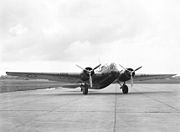 The B-10 began a revolution in bomber design. Its all-metal monoplane build, along with its features of closed cockpits, rotating gun turrets, retractable landing gear, internal bomb bay, and full engine cowlings, would become the standard for bomber designs worldwide for decades. It made all existing bombers completely obsolete. In 1932, Martin received the Collier Trophy
The B-10 began a revolution in bomber design. Its all-metal monoplane build, along with its features of closed cockpits, rotating gun turrets, retractable landing gear, internal bomb bay, and full engine cowlings, would become the standard for bomber designs worldwide for decades. It made all existing bombers completely obsolete. In 1932, Martin received the Collier Trophy
for designing the XB-10.
The B-10 began as the Martin Model 123, a private venture by the Glenn L. Martin Company
of Baltimore, Maryland. It had a crew of four: pilot
, copilot, nose gunner
and fuselage gunner
. As in previous bombers, the four crew compartments were open, but it had a number of design innovations as well.
These innovations included a deep belly for an internal bomb bay
and retractable main landing gear
. Its 600 hp (447 kW) Wright SR-1820-E
Cyclone engines provided sufficient power. The Model 123 first flew on 16 February 1932 and was delivered for testing to the U.S. Army on 20 March as the XB-907. After testing it was sent back to Martin for redesigning and was rebuilt as the XB-10.
The XB-10 delivered to the Army had major difference from the original aircraft. Where the Model 123 had NACA cowling
rings, the XB-10 had full engine cowlings to decrease drag. It also sported a pair of 675 hp (503 kW) Wright R-1820
-19 engines, and an eight-ft increase in the wingspan, along with an enclosed nose turret. When the XB-10 flew during trials in June, it recorded a speed of 197 mph (317 km/h) at 6,000 ft (1,830 m). This was an impressive performance for 1932.
Following the success of the XB-10, a number of changes were made, including reduction to a three-man crew, addition of canopies
for all crew positions, and an upgrade to 675 hp (503 kW) engines. The Army ordered 48 of these on 17 January 1933. The first 14 aircraft were designated YB-10 and delivered to Wright Field
, starting in November 1933. The production model of the XB-10, the YB-10 was very similar to its prototype.
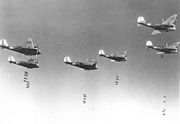
 In 1935, the Army ordered an additional 103 aircraft designated B-10B. These had only minor changes from the YB-10. Shipments began in 1935
In 1935, the Army ordered an additional 103 aircraft designated B-10B. These had only minor changes from the YB-10. Shipments began in 1935
July.
B-10Bs served with the 2d Bomb Group
at Langley Field, the 9th Bomb Group
at Mitchel Field, the 19th Bomb Group
at March Field, the 6th Composite Group
in the Panama Canal Zone
, and the 4th Composite Group in the Philippines
. In addition to conventional duties in the bomber role, some modified YB-10s and B-12As were operated for a time on large twin floats for coastal patrol.
The Martin Model 139 was the export version of the Martin B-10. With an advanced performance, the Martin company fully expected that export orders for the B-10 would come flooding in.
The Army owned the rights to the Model 139 design. Once the Army's orders had been filled in 1936, Martin received permission to export Model 139s, and delivered versions to several air forces. For example, six Model 139Ws were sold to Siam in April 1937, powered by Wright R-1820
-G3 Cyclone engines; 20 Model 139Ws were sold to Turkey
in September 1937, powered by R-1820-G2 engines.
described it as the air power wonder of its day. It was 1.5 times as fast as any biplane bomber, and faster than any contemporary fighter. The B-10 began a revolution in bomber design; it made all existing bombers completely obsolete.
However, the rapid advances in bomber design in the 1930s meant that the B-10 was eclipsed by the Boeing B-17 Flying Fortress and Douglas B-18 Bolo before the United States entered World War II
. The B-10's obsolescence was proved by the quick defeat of B-10B squadrons by Japan
ese Zeros during the invasions of the Dutch East Indies
and China
.
An abortive effort to modernize the design, the Martin Model 146
was entered into a USAAC long-distance bomber design competition 1934–1935, lost out to the Douglas B-18 and revolutionary Boeing B-17. The sole prototype was so similar in profile and performance to the Martin B-10 series that the other more modern designs easily "ran away" with the competition.
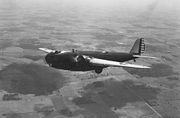
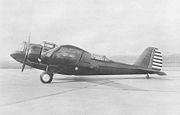
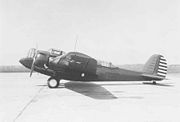

 Martin Model 123
Martin Model 123
XB-907
XB-907A
XB-10
YB-10
B-10
RB-10MA
YB-10A
B-10B
B-10M
YB-12
B-12A
YB-13
XB-14
A-15
YO-45
Martin Model 139
Model 139WA
Model 139WAA
Model 139WAN
Model 139WC
Model 139WH
Model 139WS
Model 139WSM
Model 139WSP
Model 139WT

 Dutch East Indies
Dutch East Indies
 Thailand Siam
Thailand Siam
 United States
United States
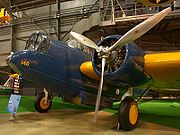
Monoplane
A monoplane is a fixed-wing aircraft with one main set of wing surfaces, in contrast to a biplane or triplane. Since the late 1930s it has been the most common form for a fixed wing aircraft.-Types of monoplane:...
bomber
Bomber
A bomber is a military aircraft designed to attack ground and sea targets, by dropping bombs on them, or – in recent years – by launching cruise missiles at them.-Classifications of bombers:...
to go into regular use by the United States Army Air Corps
United States Army Air Corps
The United States Army Air Corps was a forerunner of the United States Air Force. Renamed from the Air Service on 2 July 1926, it was part of the United States Army and the predecessor of the United States Army Air Forces , established in 1941...
, entering service in June 1934. It was also the first mass-produced bomber whose performance was superior to that of the Army's pursuit
Fighter aircraft
A fighter aircraft is a military aircraft designed primarily for air-to-air combat with other aircraft, as opposed to a bomber, which is designed primarily to attack ground targets...
aircraft
Aircraft
An aircraft is a vehicle that is able to fly by gaining support from the air, or, in general, the atmosphere of a planet. An aircraft counters the force of gravity by using either static lift or by using the dynamic lift of an airfoil, or in a few cases the downward thrust from jet engines.Although...
of the time.
The B-10 served as the airframe for the B-12, B-13, B-14, A-15 and O-45 designations using Pratt & Whitney engines instead of Wright Cyclones.
Design and development

Collier Trophy
The Collier Trophy is an annual aviation award administered by the U.S. National Aeronautics Association , presented to those who have made "the greatest achievement in aeronautics or astronautics in America, with respect to improving the performance, efficiency, and safety of air or space...
for designing the XB-10.
The B-10 began as the Martin Model 123, a private venture by the Glenn L. Martin Company
Glenn L. Martin Company
The Glenn L. Martin Company was an American aircraft and aerospace manufacturing company that was founded by the aviation pioneer Glenn L. Martin. The Martin Company produced many important aircraft for the defense of the United States and its allies, especially during World War II and the Cold War...
of Baltimore, Maryland. It had a crew of four: pilot
Aviator
An aviator is a person who flies an aircraft. The first recorded use of the term was in 1887, as a variation of 'aviation', from the Latin avis , coined in 1863 by G. de la Landelle in Aviation Ou Navigation Aérienne...
, copilot, nose gunner
Air gunner
An air gunner a.k.a. aerial gunner is a member of an air force aircrew who operates flexible-mount or turret-mounted machine guns or autocannons in an aircraft...
and fuselage gunner
Air gunner
An air gunner a.k.a. aerial gunner is a member of an air force aircrew who operates flexible-mount or turret-mounted machine guns or autocannons in an aircraft...
. As in previous bombers, the four crew compartments were open, but it had a number of design innovations as well.
These innovations included a deep belly for an internal bomb bay
Bomb bay
The bomb bay or weapons bay on some military aircraft is a compartment to carry bombs, usually in the aircraft's fuselage, with "bomb bay doors" which open at the bottom. The bomb bay doors are opened and the bombs are dropped when over the target or at a specified launching point.Large-sized...
and retractable main landing gear
Undercarriage
The undercarriage or landing gear in aviation, is the structure that supports an aircraft on the ground and allows it to taxi, takeoff and land...
. Its 600 hp (447 kW) Wright SR-1820-E
Wright R-1820
|-See also:-References:* Bridgman, L, Jane's Fighting Aircraft of World War II. Crescent. ISBN 0-517-67964-7* Eden, Paul & Soph Moeng, The Complete Encyclopedia of World Aircraft. Amber Books Ltd. Bradley's Close, 74-77 White Lion Street, London, NI 9PF, 2002, ISBN 0-7607-3432-1), 1152...
Cyclone engines provided sufficient power. The Model 123 first flew on 16 February 1932 and was delivered for testing to the U.S. Army on 20 March as the XB-907. After testing it was sent back to Martin for redesigning and was rebuilt as the XB-10.
The XB-10 delivered to the Army had major difference from the original aircraft. Where the Model 123 had NACA cowling
NACA cowling
The NACA cowling is a type of aerodynamic fairing used to streamline radial engines for use on airplanes and developed by the National Advisory Committee for Aeronautics in 1927...
rings, the XB-10 had full engine cowlings to decrease drag. It also sported a pair of 675 hp (503 kW) Wright R-1820
Wright R-1820
|-See also:-References:* Bridgman, L, Jane's Fighting Aircraft of World War II. Crescent. ISBN 0-517-67964-7* Eden, Paul & Soph Moeng, The Complete Encyclopedia of World Aircraft. Amber Books Ltd. Bradley's Close, 74-77 White Lion Street, London, NI 9PF, 2002, ISBN 0-7607-3432-1), 1152...
-19 engines, and an eight-ft increase in the wingspan, along with an enclosed nose turret. When the XB-10 flew during trials in June, it recorded a speed of 197 mph (317 km/h) at 6,000 ft (1,830 m). This was an impressive performance for 1932.
Following the success of the XB-10, a number of changes were made, including reduction to a three-man crew, addition of canopies
Canopy (aircraft)
An aircraft canopy is the transparent enclosure over the cockpit of some types of aircraft. The function of the canopy is to provide a weatherproof and reasonably quiet environment for the aircraft's occupants. The canopy will be as aerodynamically shaped as possible to minimize drag.-History:Very...
for all crew positions, and an upgrade to 675 hp (503 kW) engines. The Army ordered 48 of these on 17 January 1933. The first 14 aircraft were designated YB-10 and delivered to Wright Field
Wright Field
Wright Field was an airfield of the United States Army Air Corps and Air Forces near Riverside, Ohio. From 1927 to 1947 it was the research and development center for the Air Corps, and during World War II a flight test center....
, starting in November 1933. The production model of the XB-10, the YB-10 was very similar to its prototype.
Operational history


1935 in aviation
This is a list of aviation-related events from 1935:- Events :* Employing aerial refueling, a sustained flight record of 653 hours 33 minutes is set...
July.
B-10Bs served with the 2d Bomb Group
2d Operations Group
The 2d Operations Group is the flying component of the United States Air Force 2d Bomb Wing, assigned to the Air Combat Command Eighth Air Force. The group is stationed at Barksdale Air Force Base, Louisiana....
at Langley Field, the 9th Bomb Group
9th Operations Group
The 9th Operations Group is the operational flying component of the 9th Reconnaissance Wing, stationed at Beale Air Force Base, California....
at Mitchel Field, the 19th Bomb Group
19th Operations Group
The 19th Operations Group is the operational flying component of the United States Air Force 19th Airlift Wing, stationed at Little Rock Air Force Base, Arkansas....
at March Field, the 6th Composite Group
6th Operations Group
The 6th Operations Group is the operational flying component of the 6th Air Mobility Wing, stationed at MacDill Air Force Base, Florida....
in the Panama Canal Zone
Panama Canal Zone
The Panama Canal Zone was a unorganized U.S. territory located within the Republic of Panama, consisting of the Panama Canal and an area generally extending 5 miles on each side of the centerline, but excluding Panama City and Colón, which otherwise would have been partly within the limits of...
, and the 4th Composite Group in the Philippines
Philippines
The Philippines , officially known as the Republic of the Philippines , is a country in Southeast Asia in the western Pacific Ocean. To its north across the Luzon Strait lies Taiwan. West across the South China Sea sits Vietnam...
. In addition to conventional duties in the bomber role, some modified YB-10s and B-12As were operated for a time on large twin floats for coastal patrol.
The Martin Model 139 was the export version of the Martin B-10. With an advanced performance, the Martin company fully expected that export orders for the B-10 would come flooding in.
The Army owned the rights to the Model 139 design. Once the Army's orders had been filled in 1936, Martin received permission to export Model 139s, and delivered versions to several air forces. For example, six Model 139Ws were sold to Siam in April 1937, powered by Wright R-1820
Wright R-1820
|-See also:-References:* Bridgman, L, Jane's Fighting Aircraft of World War II. Crescent. ISBN 0-517-67964-7* Eden, Paul & Soph Moeng, The Complete Encyclopedia of World Aircraft. Amber Books Ltd. Bradley's Close, 74-77 White Lion Street, London, NI 9PF, 2002, ISBN 0-7607-3432-1), 1152...
-G3 Cyclone engines; 20 Model 139Ws were sold to Turkey
Turkey
Turkey , known officially as the Republic of Turkey , is a Eurasian country located in Western Asia and in East Thrace in Southeastern Europe...
in September 1937, powered by R-1820-G2 engines.
Legacy
At the time of its creation, the B-10B was so advanced that General Henry H. ArnoldHenry H. Arnold
Henry Harley "Hap" Arnold was an American general officer holding the grades of General of the Army and later General of the Air Force. Arnold was an aviation pioneer, Chief of the Air Corps , Commanding General of the U.S...
described it as the air power wonder of its day. It was 1.5 times as fast as any biplane bomber, and faster than any contemporary fighter. The B-10 began a revolution in bomber design; it made all existing bombers completely obsolete.
However, the rapid advances in bomber design in the 1930s meant that the B-10 was eclipsed by the Boeing B-17 Flying Fortress and Douglas B-18 Bolo before the United States entered World War II
World War II
World War II, or the Second World War , was a global conflict lasting from 1939 to 1945, involving most of the world's nations—including all of the great powers—eventually forming two opposing military alliances: the Allies and the Axis...
. The B-10's obsolescence was proved by the quick defeat of B-10B squadrons by Japan
Japan
Japan is an island nation in East Asia. Located in the Pacific Ocean, it lies to the east of the Sea of Japan, China, North Korea, South Korea and Russia, stretching from the Sea of Okhotsk in the north to the East China Sea and Taiwan in the south...
ese Zeros during the invasions of the Dutch East Indies
Dutch East Indies
The Dutch East Indies was a Dutch colony that became modern Indonesia following World War II. It was formed from the nationalised colonies of the Dutch East India Company, which came under the administration of the Netherlands government in 1800....
and China
China
Chinese civilization may refer to:* China for more general discussion of the country.* Chinese culture* Greater China, the transnational community of ethnic Chinese.* History of China* Sinosphere, the area historically affected by Chinese culture...
.
An abortive effort to modernize the design, the Martin Model 146
Martin Model 146
|-See also:-References:* Baugher, Joe. "Martin B-10". Encyclopedia of American Aircraft. Access date: 4 July 2007.* Taylor, John W. R. "Martin B-10". Combat Aircraft of the World from 1909 to the Present. New York: G.P. Putnam's Sons, 1969. ISBN 0-425-03633-2.-External links:*...
was entered into a USAAC long-distance bomber design competition 1934–1935, lost out to the Douglas B-18 and revolutionary Boeing B-17. The sole prototype was so similar in profile and performance to the Martin B-10 series that the other more modern designs easily "ran away" with the competition.
Variants





- Private venture of Martin company, predecessor of the XB-10, served as prototype for the series.
XB-907
- US Army designation for the Model 123 in evaluation
XB-907A
- Modified XB-907 after Martin returned it to U.S. Army for further operational trials
XB-10
- Designation of the XB-907A when purchased by the United States Army Air Corps, Modified Martin Model 123 with full engine cowlings, fully rotating nose glass turret, more powerful engines, and increased wingspan.
YB-10
- Model 139, production version of the XB-10 with crew reduced to three members, canopies for all crew members and better engines (675 hp/503 kW R-1820-25), 14 built, some flown temporarily as float planes.
B-10
- Two additional aircraft ordered in 1936.
RB-10MA
- One former NEIAF Model 139WH-3A model impressed in July 1942 and flown from Australia to the United States.
YB-10A
- The YB-10A was different from a YB-10 only in its engines. It used Wright R-1820Wright R-1820|-See also:-References:* Bridgman, L, Jane's Fighting Aircraft of World War II. Crescent. ISBN 0-517-67964-7* Eden, Paul & Soph Moeng, The Complete Encyclopedia of World Aircraft. Amber Books Ltd. Bradley's Close, 74-77 White Lion Street, London, NI 9PF, 2002, ISBN 0-7607-3432-1), 1152...
-31 turbo-supercharged radials, allowing it to attain speeds of 236 mph (380 km/h). This made it the fastest aircraft of the B-10 series. Despite this advantage, only one was built, as a test aircraft.
B-10B
- Main production version with two 775 hp (578 kW) R-1820-33 engines, 103 built.
B-10M
- A number of B-10Bs converted as target tugs.
YB-12
- Re-engined version of the YB-10 with Pratt & Whitney R-1690Pratt & Whitney R-1690|-See also:-External links:*...
-11 "Hornet" radial engines. These 775 hp (578 kW) engines gave similar performance to those on the B-10B (218 mph/351 km/h), seven built.
B-12A
- The production version of the YB-12 with provision for a 365 gal (1,381 l) bomb bay tank, giving the B-12A a combat range of 1,240 mi (1,995 km), 25 built.
YB-13
- Re-engined version of the YB-10 powered by two 700 hp (522 kW) Pratt & Whitney R-1860-17 radial engines. Ten were on order but cancelled before production started, not built.
XB-14
- The last of the 48 XB-10–airframes ordered by the army was a version of the YB-10 using Pratt & Whitney YR-1830-9 "Twin Wasp" radial engines, one built.
A-15
- Proposed attack variant of the YB-10 with two 750 hp (559 kW) R-1820-25 engines, was never built. The contract fell to the A-14 Shrike.
YO-45
- One YB-10 temporarily tested in the high-speed observation role.
Martin Model 139
- Martin export version of the B-10 bomber, six sold to Siam
Model 139WA
- Martin demonstrator for Argentina
Model 139WAA
- Export version for Argentine Army, 26 built
Model 139WAN
- Export version for the Argentine Navy, 12 built.
Model 139WC
- Export version for China, six built.
Model 139WH
- Export version to Netherlands for use in the Dutch East Indies. Produced in block series H-1 (13 built), H-2 (26 built) and H-3. The 139WH-3 (also known as the Model 166) had two 900 hp (671 kW) R-1820-G102 and single long dorsal canopy, 39 built. The 139W-3A (also known as the Model 166A) as WH-3 with equipment changes, 39 built. A total of 116 were built for the Dutch.
Model 139WS
- Single demonstrator to the Soviet Union.
Model 139WSM
- Export version for Siam, 6 built.
Model 139WSP
- Proposed licence built version to be built by CASA of Spain, production blocked by U.S. State Department.
Model 139WT
- Export version for Turkey, 20 built
Operators

- Argentine Air ForceArgentine Air ForceThe Argentine Air Force is the national aviation branch of the Armed Forces of the Argentine Republic. , it had 14,606 military and 6,854 civilian staff.-History:...
received 27 Model 139W/WAA aircraft. - Argentine NavyArgentine NavyThe Navy of the Argentine Republic or Armada of the Argentine Republic is the navy of Argentina. It is one of the three branches of the Armed Forces of the Argentine Republic, together with the Army and the Air Force....
- The Argentine Naval AviationArgentine Naval AviationThe Argentine Naval Aviation is the naval aviation branch of the Argentine Navy and one of its four operational commands...
received 13 Model 139WAN aircraft.
- Chinese Nationalist Air Force
 Dutch East Indies
Dutch East Indies
- Royal Netherlands East Indies Army Air ForceRoyal Netherlands East Indies Army Air ForceThe Royal Netherlands East Indies Army Air Force was the air arm of the Royal Netherlands East Indies Army in the Dutch East Indies from 1939 until 1950...
- Indonesian Air ForceIndonesian Air ForceThe Indonesian Air Force is the air force branch of the Indonesian National Armed Forces.The Indonesian Air Force has 34,930 personnel equipped with 110 combat aircraft including Su-27 and Su-30.-Before Indonesian independence :...
took over several numbers of B-10, passed to Indonesian guerillas from Netherlands East Indies in 1945.
- Philippine Army Air CorpsPhilippine Army Air CorpsThe Philippine Army Air Corps was created by the Philippine National Assembly's National Defense Act of 1935. By 1940, the corps had around 40 aircraft and 100 pilots, 500 personnel, and six squadrons...
 Thailand Siam
Thailand Siam
- Royal Thai Air ForceRoyal Thai Air ForceThe Royal Thai Air Force or RTAF is the air force of the Kingdom of Thailand. Since its establishment in 1913, as one of the earliest air forces of Asia, the Royal Thai Air Force had engaged in many major and minor battles. During the Vietnam war era, the air force has been developed with USAF-aid...
received six Model 139W aircraft in April 1937 and used them during the French-Thai WarFrench-Thai WarThe Franco-Thai War was fought between Thailand and Vichy France over certain areas of French Indochina that had once belonged to Thailand....
of 1940-41, and during the 1942 invasion of Burma. It was given a further nine ex-Dutch aircraft by the Japanese in 1942. They remained in service until 1949.
- Turkish Air ForceTurkish Air ForceThe Turkish Air Force is the aerial warfare service branch of the Turkish Armed Forces. It ranks 3rd in NATO in terms of fleet size behind the USAF and Royal Air Force with a current inventory of 798 aircraft .-Initial stages:...
received 20 Model 139W aircraft in September 1937.
- Soviet Air ForceSoviet Air ForceThe Soviet Air Force, officially known in Russian as Военно-воздушные силы or Voenno-Vozdushnye Sily and often abbreviated VVS was the official designation of one of the air forces of the Soviet Union. The other was the Soviet Air Defence Forces...
bought one aircraft for evaluation.
 United States
United States
- United States Army Air CorpsUnited States Army Air CorpsThe United States Army Air Corps was a forerunner of the United States Air Force. Renamed from the Air Service on 2 July 1926, it was part of the United States Army and the predecessor of the United States Army Air Forces , established in 1941...
Survivors

- The only surviving complete B-10 is on display at the National Museum of the United States Air ForceNational Museum of the United States Air ForceThe National Museum of the United States Air Force is the official museum of the United States Air Force located at Wright-Patterson Air Force Base northeast of Dayton, Ohio. The NMUSAF is the world's largest and oldest military aviation museum with more than 360 aircraft and missiles on display...
at Wright-Patterson Air Force BaseWright-Patterson Air Force BaseWright-Patterson Air Force Base is a United States Air Force base in Greene and Montgomery counties in the state of Ohio. It includes both Wright and Patterson Fields, which were originally Wilbur Wright Field and Fairfield Aviation General Supply Depot. Patterson Field is located approximately...
near Dayton, OhioDayton, OhioDayton is the 6th largest city in the U.S. state of Ohio and the county seat of Montgomery County, the fifth most populous county in the state. The population was 141,527 at the 2010 census. The Dayton Metropolitan Statistical Area had a population of 841,502 in the 2010 census...
. The aircraft is painted as a B-10 used in the 1934 Alaskan Flight. It was an export version sold to ArgentinaArgentinaArgentina , officially the Argentine Republic , is the second largest country in South America by land area, after Brazil. It is constituted as a federation of 23 provinces and an autonomous city, Buenos Aires...
in 1938. The aircraft survived as a ground crew trainer, and was still being used by the Argentine Air Force for training its ground crews as late as the 1960s. The Air Force Museum conducted an exhaustive search for any surviving B-10 remains, and eventually learned of the aircraft. In 1970, the incomplete airframe was donated by the Government of Argentina to the U.S. Government in a formal ceremony attended by the U.S. ambassador. The aircraft was restored by the 96th Maintenance Squadron (Mobile), Air Force Reserve, at Kelly Air Force BaseKelly Air Force BaseKelly Field Annex and is a former United States Air Force facility located in San Antonio, Texas. In 2001, the runway and land west of the runway became "Kelly Field Annex" and control of it was transferred to the adjacent Lackland Air Force Base, part of Joint Base San Antonio...
, Texas, in 1973–1976,and placed on display in 1976.
- Various parts of crashed B-10s, such as turretTurretIn architecture, a turret is a small tower that projects vertically from the wall of a building such as a medieval castle. Turrets were used to provide a projecting defensive position allowing covering fire to the adjacent wall in the days of military fortification...
s and wingWingA wing is an appendage with a surface that produces lift for flight or propulsion through the atmosphere, or through another gaseous or liquid fluid...
s, were retrieved from the jungleJungleA Jungle is an area of land in the tropics overgrown with dense vegetation.The word jungle originates from the Sanskrit word jangala which referred to uncultivated land. Although the Sanskrit word refers to "dry land", it has been suggested that an Anglo-Indian interpretation led to its...
of BorneoBorneoBorneo is the third largest island in the world and is located north of Java Island, Indonesia, at the geographic centre of Maritime Southeast Asia....
and are now on display in the Militaire-Luchtvaartmuseum (Military Aviation Museum) at Soesterberg, the NetherlandsNetherlandsThe Netherlands is a constituent country of the Kingdom of the Netherlands, located mainly in North-West Europe and with several islands in the Caribbean. Mainland Netherlands borders the North Sea to the north and west, Belgium to the south, and Germany to the east, and shares maritime borders...
.

